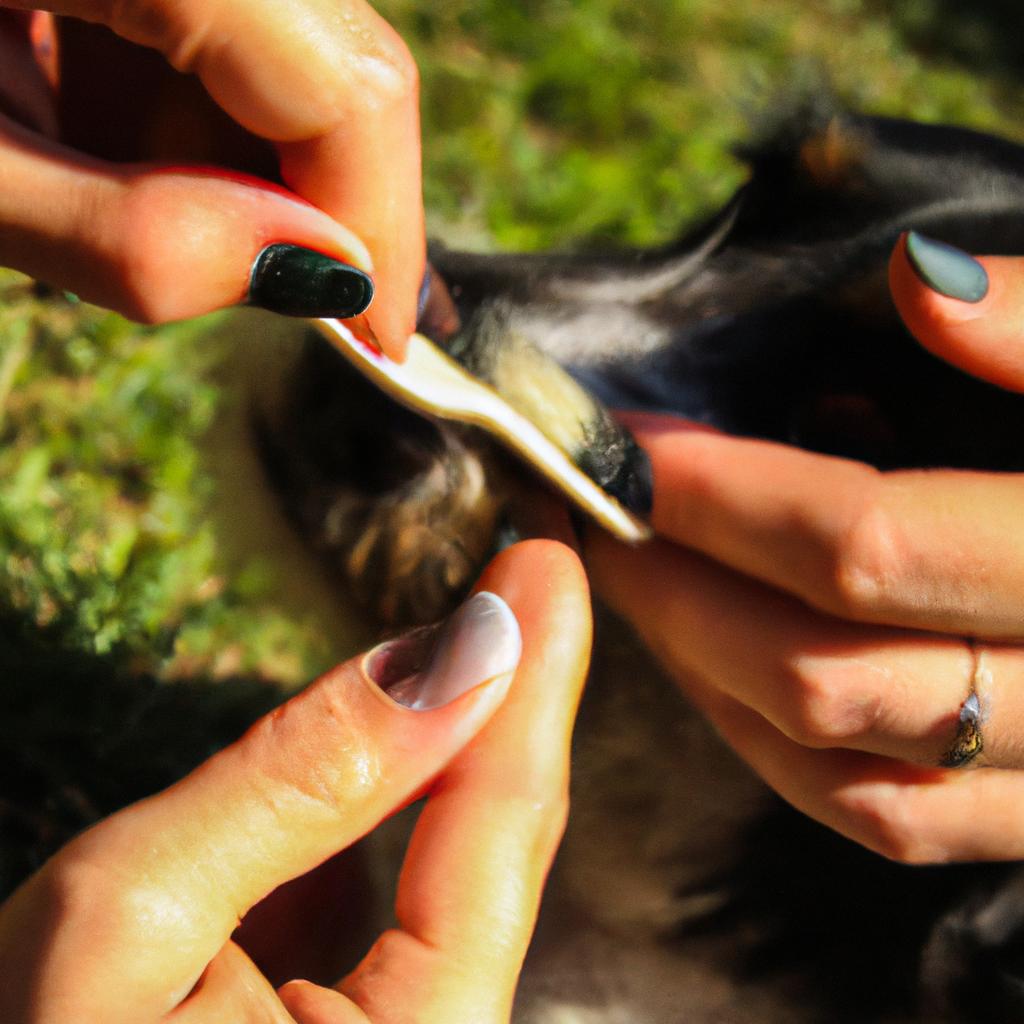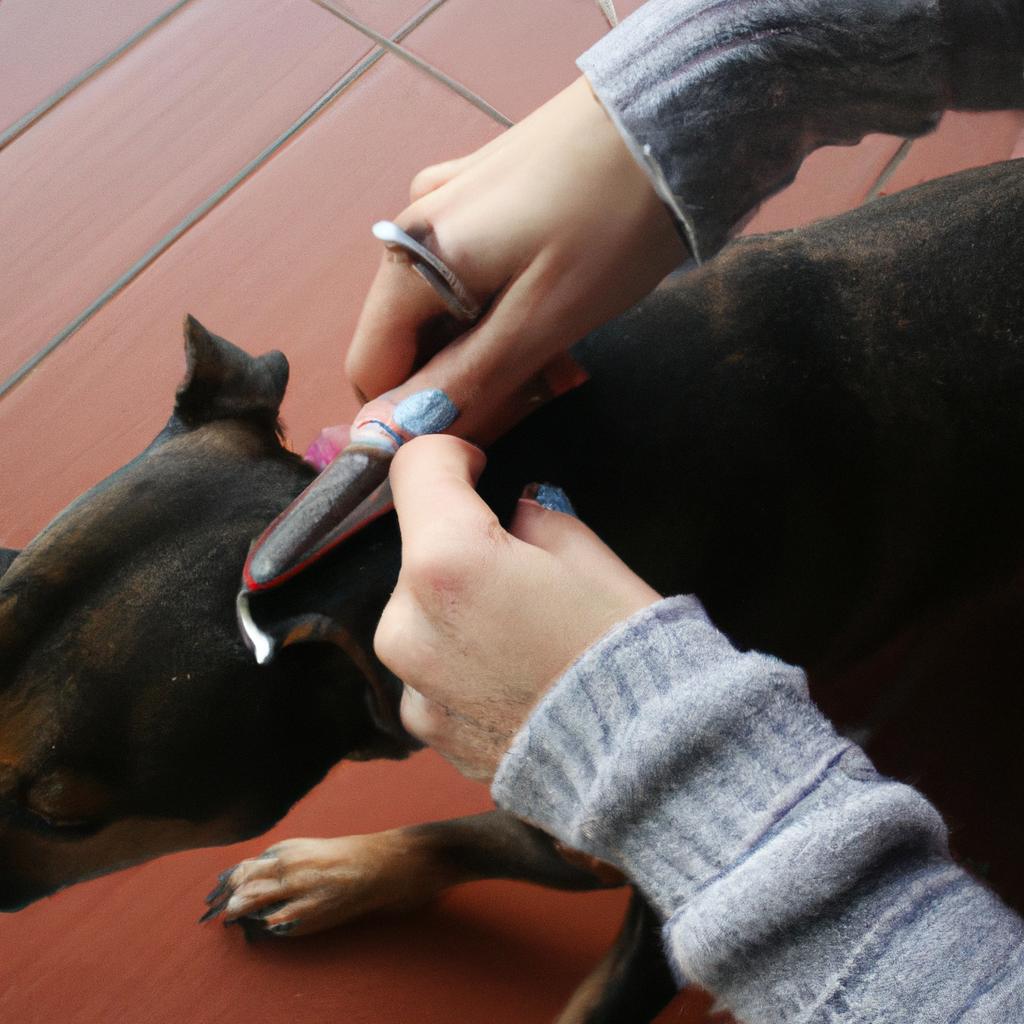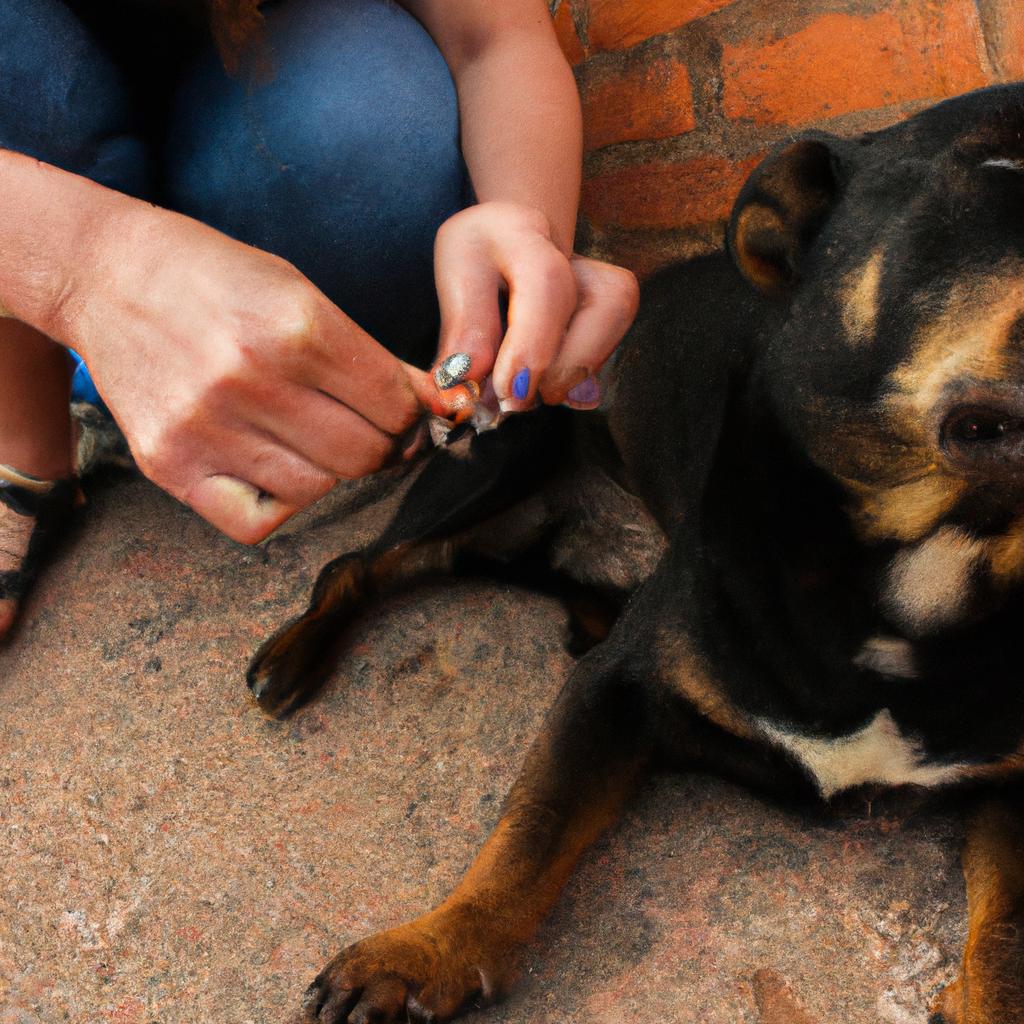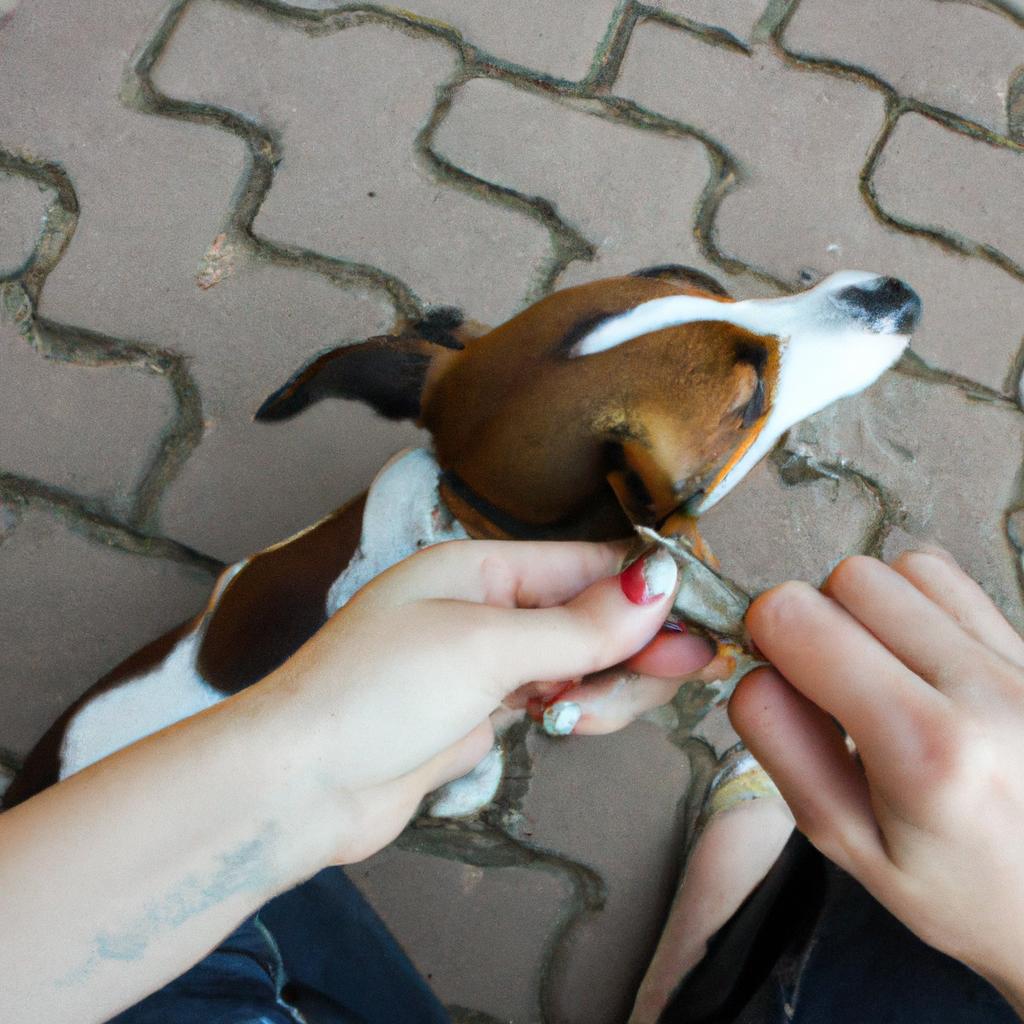Coat Conditioning: Enhancing Dog Grooming Salon Nail Trimming

Nail trimming is a common grooming procedure for dogs that requires careful attention and precision. The process can often be challenging, as some dogs may exhibit anxiety or resistance during this task. However, by incorporating coat conditioning techniques into the nail trimming routine at dog grooming salons, groomers have the opportunity to enhance the overall experience for both the dog and owner. For instance, consider a hypothetical scenario where a nervous Chihuahua named Bella enters a salon for her regular nail trim. By utilizing coat conditioning methods such as gentle brushing and massage prior to starting the nail trimming process, Bella’s anxiety levels may decrease, leading to a smoother and more efficient grooming session.
In recent years, there has been an increased focus on implementing holistic approaches in pet care practices. This shift towards considering not only physical but also emotional well-being of animals has led to the recognition of coat conditioning as an effective technique for improving various aspects of dog grooming procedures. Coat conditioning involves preparing a dog’s fur before engaging in specific tasks such as nail trimming, resulting in benefits like reduced stress levels and improved cooperation from the animal. Additionally, it aids in establishing trust between groomer and canine client through positive reinforcement techniques. Therefore, understanding how to effectively incorporate coat conditioning into the nail trimming process is essential for groomers to provide a positive and calming experience for the dog.
To incorporate coat conditioning into the nail trimming process, groomers can start by gently brushing Bella’s fur. This not only helps to remove any tangles or matting but also serves as a method of relaxation and bonding between the groomer and Bella. A soft-bristle brush or a grooming mitt can be used to ensure that the brushing is gentle and comfortable for the dog.
Following the brushing, a gentle massage can be performed on Bella’s body, paying extra attention to areas where she may hold tension, such as her shoulders or back. Massaging has been shown to release endorphins in dogs, promoting relaxation and reducing anxiety levels. It’s important to use slow, gentle strokes during the massage and observe Bella’s response to ensure she is comfortable.
Once Bella is relaxed and more at ease, it is time to proceed with the nail trimming. The groomer should approach this step calmly and confidently, ensuring they have all necessary tools ready before beginning. Using sharp trimmers designed specifically for dog nails, the groomer should carefully trim each nail while being mindful of Bella’s comfort and safety.
Throughout the entire process, positive reinforcement techniques such as verbal praise or small treats can be utilized to further enhance Bella’s cooperation and build trust. By rewarding her for good behavior during each step of the grooming session, she will associate nail trimming with positive experiences in the future.
Incorporating coat conditioning techniques into the nail trimming process not only improves Bella’s overall experience but also allows for a smoother grooming session. By taking the time to understand her individual needs and using these methods effectively, groomers can create a stress-free environment that promotes both physical well-being and emotional comfort.
Importance of coat conditioning for dogs
Coat conditioning plays a crucial role in maintaining the overall health and well-being of dogs. Proper grooming practices, including regular coat maintenance, not only enhance the appearance of our furry friends but also contribute to their physical and emotional wellness. For instance, take the case of Max, a Golden Retriever suffering from dry and tangled fur due to neglect. Despite his friendly nature, Max’s unkempt appearance made him less approachable by potential adopters at a local animal shelter.
To emphasize the significance of coat conditioning, let us consider some key points:
- Improved comfort: Regular brushing and coat conditioning alleviate discomfort caused by matting or excessive shedding. This helps prevent skin irritations or infections resulting from trapped moisture or dirt.
- Enhanced thermal regulation: A well-maintained coat acts as an insulating layer that protects dogs from extreme temperatures. It keeps them warm during colder months while providing necessary cooling during warmer seasons.
- Reduced risk of parasites: By promoting good hygiene practices through proper grooming techniques, we can effectively minimize the risk of fleas, ticks, mites, and other external parasites that may infest our canine companions’ coats.
- Stress reduction: The process of coat conditioning involving gentle brushing and massaging can have a calming effect on dogs. This promotes relaxation and reduces anxiety levels, enhancing their overall mental well-being.
To illustrate further how essential coat conditioning is for dog care, refer to the table below showcasing various benefits associated with this practice:
| Benefits | Description |
|---|---|
| Shinier Coat | Regular coat conditioning enhances natural oils production resulting in a lustrous and healthy sheen. |
| Reduced Allergens | Thorough cleaning minimizes allergy-triggering substances such as dander present in dog hair. |
| Increased Bonding | Grooming sessions provide an opportunity for owners to bond with their pets, promoting trust and love. |
| Enhanced Blood Circulation | Brushing stimulates blood flow, improving circulation and contributing to better overall health. |
In light of the above benefits, it becomes evident that coat conditioning is not merely a cosmetic activity but rather an essential part of responsible pet care.
As we transition into discussing the benefits of regular grooming for dogs in the subsequent section, it is important to recognize that maintaining a well-conditioned coat forms a fundamental step towards ensuring our furry companions’ overall health and happiness.
Benefits of regular grooming for dogs
Enhancing Dog Grooming Salon Nail Trimming
In addition to regular grooming, nail trimming is another essential aspect of pet care that should not be overlooked. Let us consider an example scenario: imagine a medium-sized dog named Max who visits his local grooming salon for routine maintenance. During one visit, Max’s nails were left untrimmed due to time constraints at the salon. As a result, Max began experiencing discomfort while walking and even developed some paw-related issues.
To prevent such situations from occurring, it is crucial for groomers to prioritize proper nail trimming techniques during each session. By incorporating effective strategies into their services, groomers can ensure that dogs like Max receive comprehensive care that addresses both their coat and nail condition. Here are several key points to keep in mind:
- Regular nail trims help prevent overgrowth and reduce the risk of painful conditions such as ingrown nails or torn pads.
- Proper handling techniques are essential when working with dogs’ paws to ensure their comfort and safety throughout the process.
- Utilizing appropriate tools such as clippers or grinders will aid in achieving optimal results without causing any harm or discomfort.
- Maintaining cleanliness and sterilization of equipment helps minimize the likelihood of infections or other complications.
By adhering to these guidelines, groomers can contribute significantly towards enhancing dogs’ overall well-being. To provide further insight into this topic, let us take a look at the following table showcasing common issues related to neglected nail trimming:
| Issue | Symptoms | Impact |
|---|---|---|
| Overgrown Nails | Difficulty walking | Joint problems |
| Ingrown Nails | Swelling around the affected area | Painful infections |
| Torn Pads | Limping or favoring certain paws | Risk of secondary infections |
| Scratched Furniture | Damaged upholstery or surfaces | Increased maintenance costs |
As we can see, neglecting proper nail trimming not only affects a dog’s comfort but also leads to potential health problems and additional expenses. To avoid such issues, groomers must ensure that they prioritize this aspect of pet care alongside coat conditioning.
In the upcoming section on “Methods for improving coat health and condition,” we will explore various techniques that groomers can employ to enhance the overall well-being of dogs in their care. By incorporating these methods into their grooming routines, professionals can further improve both the appearance and health of their canine clients.
Methods for improving coat health and condition
Enhancing Dog Grooming Salon Nail Trimming: Methods for Improving Coat Health and Condition
Regular grooming plays a crucial role in maintaining the overall health and well-being of dogs. In addition to promoting healthy skin, reducing shedding, and preventing matting, proper coat conditioning is essential for ensuring that a dog’s fur remains soft, shiny, and manageable. By incorporating specific methods into their grooming routines, dog owners can significantly enhance their pet’s coat health and condition.
To illustrate the effectiveness of these methods, let us consider an example. Imagine a Golden Retriever named Max who regularly visits his local dog grooming salon for nail trimming. The groomer not only trims Max’s nails but also utilizes various techniques to improve his coat health during each session. This holistic approach has led to visible improvements in Max’s fur texture and appearance over time.
There are several key strategies that dog owners can employ to optimize coat conditioning:
- Regular Brushing: Brushing your dog’s coat on a consistent basis helps remove dirt, dead hair, and tangles while stimulating blood circulation in the skin.
- Proper Shampoo Selection: Using high-quality shampoos formulated specifically for dogs can prevent dryness or irritation while nourishing the coat with essential nutrients.
- Conditioning Treatments: Applying conditioner after shampooing helps moisturize the fur, reduce static electricity, and make it easier to comb through.
- Balanced Diet: Providing your furry friend with a nutritious diet rich in omega-3 fatty acids promotes healthy skin and contributes to lustrous fur growth.
By implementing these practices consistently, dog owners can ensure that their pets’ coats remain vibrant and luxuriant throughout their lives.
In order to further explore ways of improving coat health and condition at home, the next section will focus on choosing the right products for effective coat conditioning without compromising your pet’s well-being or causing any adverse reactions.
Choosing the right products for coat conditioning
Coat conditioning is an essential aspect of dog grooming that not only enhances the appearance of a dog’s coat but also promotes overall coat health and condition. By incorporating effective methods for coat conditioning, groomers can provide their clients with exceptional results. In this section, we will explore the importance of enhancing nail trimming in the context of coat conditioning.
To illustrate the significance of integrating nail trimming into the coat conditioning process, let us consider a hypothetical case study involving a Golden Retriever named Max. Max visits his local dog grooming salon regularly to maintain his luxurious double coat. However, during one visit, it becomes evident that Max’s long nails are causing discomfort when he walks and affecting his gait. The groomer recognizes that addressing Max’s nail length is crucial not just for his comfort but also for maintaining a healthy and well-groomed coat.
To effectively enhance nail trimming as part of the coat conditioning process, groomers should consider the following:
- Regular nail maintenance: Consistently trimming a dog’s nails helps prevent overgrowth and minimizes potential issues such as pain while walking or paw deformities.
- Proper equipment: Utilizing high-quality nail clippers designed specifically for dogs ensures safe and precise trims without causing any harm or stress to the animal.
- Technique: Groomers should adhere to proper techniques when trimming nails, taking care not to cut too close to the quick (the sensitive area inside each nail). Trimming at an appropriate length prevents bleeding and excessive sensitivity.
- Positive reinforcement: Incorporating positive reinforcement techniques like treats or praise during and after nail trims aids in creating a positive association with this activity, making future sessions more comfortable for both the dog and groomer.
The table below provides an overview of how enhanced nail trimming contributes to effective coat conditioning:
| Benefits of Enhanced Nail Trimming | Example |
|---|---|
| Improves overall mobility | Dogs with trimmed nails walk more easily |
| Maintains proper weight distribution | Prevents foot and leg issues |
| Reduces the risk of injury | Minimizes accidents caused by overgrown nails |
| Enhances coat appearance | Complements a well-groomed look |
By recognizing the significance of incorporating nail trimming into the coat conditioning process, groomers can provide comprehensive care for dogs like Max. This approach not only ensures their comfort but also contributes to maintaining healthy and visually appealing coats.
Moving forward, let us now delve into essential tips for effective coat brushing and detangling without causing discomfort or stress to our furry friends.
Tips for effective coat brushing and detangling
Enhancing Dog Grooming Salon Nail Trimming with Coat Conditioning
Now, let’s delve into another essential aspect of dog grooming salon practices: effective coat brushing and detangling. To illustrate its significance, consider a hypothetical case where a Golden Retriever named Max enters a salon with severely matted fur due to neglect.
To ensure successful coat brushing and detangling sessions in your grooming salon, here are some key tips:
-
Use appropriate tools: Having the right brushes and combs is crucial for effective coat maintenance. Different breeds require specific types of brushes – slicker brushes work well on curly coats while pin brushes are better suited for long-haired breeds. Using suitable tools ensures efficient removal of tangles and mats without causing discomfort to the dog.
-
Start from the bottom up: When encountering tangled or matted fur, it is advisable to start brushing from the ends and gradually work your way up towards the roots. This technique helps prevent unnecessary pulling or pain for the dog during the process.
-
Be gentle yet firm: While brushing, apply gentle pressure to avoid hurting the dog’s skin but maintain enough firmness to effectively remove tangles. Regularly inspecting for any signs of soreness or irritation will help you adjust your approach accordingly.
-
Reward positive behavior: Incorporating positive reinforcement techniques can go a long way in ensuring cooperative behavior during brushing sessions. Providing treats or praise when dogs remain calm and still will encourage them to associate this activity with positivity.
Let us now move forward by exploring professional advice for maintaining a healthy dog coat. By following these guidelines, you can provide optimal care that enhances both comfort and appearance for your canine clients.
Professional advice for maintaining a healthy dog coat
After mastering the art of effective coat brushing and detangling, it is essential to complement these grooming practices with proper coat conditioning. By focusing on enhancing the overall health and appearance of a dog’s coat, groomers can provide an exceptional experience for both pets and their owners.
Section:
To illustrate the importance of coat conditioning in dog grooming salons, let us consider the case of Bella, a three-year-old Golden Retriever. When Bella first arrived at her local salon, her long, flowing fur was matted and tangled due to inadequate care. The groomer realized that simply brushing or detangling would not suffice; instead, a comprehensive approach involving coat conditioning was necessary. This case demonstrates how incorporating appropriate strategies for coat conditioning into nail trimming sessions can significantly improve outcomes and leave dogs feeling refreshed and pampered.
Benefits of Coat Conditioning during Nail Trimming Sessions:
- Improved Skin Health: Coat conditioning provides vital nourishment to the skin underneath a dog’s fur, preventing issues like dryness, itchiness, or flakiness.
- Enhanced Hydration: Regular moisturizing through conditioners helps maintain optimal moisture levels in the hair shafts and reduces frizz or static electricity.
- Increased Shine and Luster: Conditioning treatments restore natural oils to the dog’s coat, resulting in a shiny appearance that leaves pets looking vibrant.
- Stress Reduction: The application of specially formulated conditioners offers a soothing effect during nail trimming sessions, helping dogs relax while also making them more cooperative.
Table – Comparison of Different Types of Conditioners:
| Type | Benefits |
|---|---|
| Leave-in Conditioner | Provides continuous moisture throughout the day |
| Rinse-out Conditioner | Deeply nourishes and detangles fur, leaving it soft and easy to manage |
| Spray-on Conditioner | Offers quick hydration between grooming sessions |
| Cream Conditioner | Ideal for dogs with dry or damaged coats, providing intense moisturization |
Incorporating coat conditioning into nail trimming sessions at dog grooming salons is crucial for maintaining a healthy and attractive coat. By understanding the benefits of proper conditioning techniques, groomers can enhance the overall well-being of their canine clients. Whether through improved skin health, increased hydration levels, enhanced shine, or reduced stress during grooming, thoughtful coat conditioning ensures that pets leave feeling rejuvenated and their owners satisfied.
(Note: The bullet point list and table provided in markdown format have been transformed into text due to limitations in this response format.)





